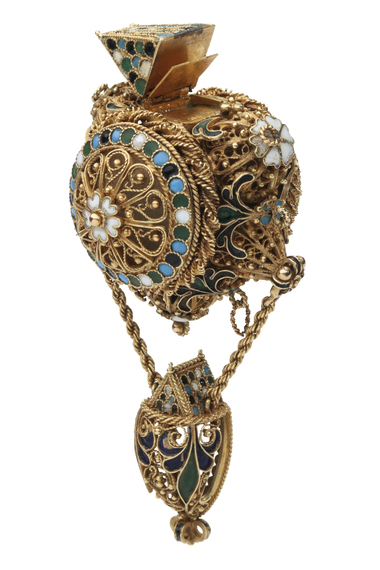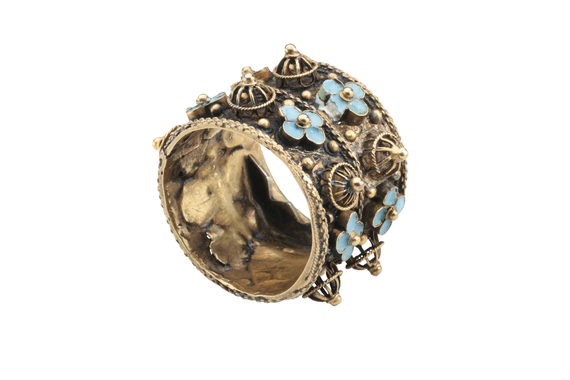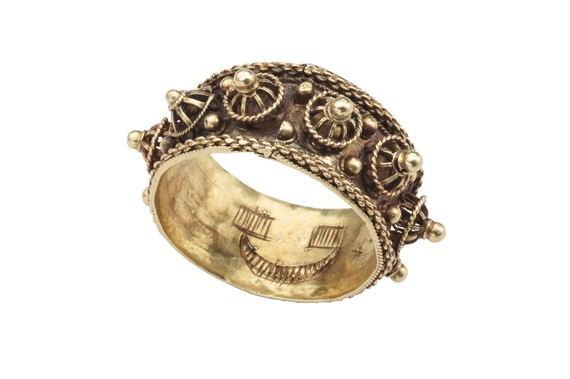I had no idea when I entered at Les Enluminures' New York Gallery for an advanced sneak preview of the exhibit and sale of "Cycles of Life: Rings from the Benjamin Zucker Family Collection" that five awe-inspiring, ancient and antique Jewish marriage rings would lead me back to the part of my past that I had not recognized since my childhood. These miniature and masterful works of cultural history spoke to me of love, of building a happy home with the warmth of generations of family and the traditions that reminded me I had misplaced my roots. The timing of viewing these rings was perfect as the Jewish holidays would begin soon with Rosh Hashanah (evening of September 24 through 26, 2014 (The Jewish New Year) and then Yom Kippur (the day of atonement) from the evening of October 3-4, 2014.
In my memoir of 2012, My Charmed Life, Rocky Romances, Precious Family Connections and Searching for A Band of Gold (NAL/Penguin), I linked together my most cherish jewelry with the significant memories each piece represented in my life. As an avid antique ring collector -- a theme which acts as a metaphor for various relationships in my memoir -- I immediately accepted the invitation to preview the 40 plus rings assembled together for the first time for public view and sale at Les Enluminures' New York gallery from October 31 through December 6, 2014. For the gallery exhibit, the rings will be displayed by themes that form the cycles of life: birth, love, betrothal, marriage, mourning, and death. While all are breathtaking in their sentimentality, meaning and historical references, my focus became the rings that would conjure up remembrances of my youth.
I grew up, a less than reformed Suburban Jewish girl with divorced parents, both whom remarried Italian Catholics. My two younger brothers and I celebrated all holidays and had Christmas trees with a star on top in the living room and a Menorah with a center star in the dining room. We had simple Passovers while readying to paint and hunt for Easter eggs. As far as marriage bands in my immediate family -- my father proposed with a watch instead of a ring. My stepfather slipped an antique diamond eternity band on my mom's left finger during her second wedding ceremony in front of a Justice of The Peace.
To say that I was reformed in my teens up to my middle-aged years might be considered an understatement. In her more tenacious, non-PC days my maternal grandmother -- Nana Ida, asked, as I was turning 40, "Why do you only date Mobster types, members of the IRA and Italian Playboys who live 5000 miles away?" (referring to my teenage boyfriends in NJ, my soulful lad from Dublin and my Milanese man with the curled vowels) she continued, "Why not find a nice Jewish man to settle down. Go to the hospital cafeteria at Mt. Sinai for lunch with wearing make up and a nice dress and maybe you can find a doctor there?" she added.
The memories of my acting on my Jewish heritage actually date back to my grandparents, particularly Nana Ida and Papa Rubin, my maternal grandparents and David and Fanny my maternal great grandparents.
With the exception of weddings and funerals -- the last time I was in a synagogue was when Ida and Rubin lived in Brooklyn and belonged to a conservative temple. My mom (their only child) drove to Brooklyn from New City, NY for Rosh Hashanah and Yom Kippur. I remember my grandfather being with his four brothers in temple all day and my grandmother and her friends in hats and little suits taking breaks outside and gossiping and sharing recipes for the food that would break the Yom Kippur fast. I turned my nose at all of these "delicacies", except for the potato "latkes" and applesauce, which she saved in a separate Tupperware container for me.
Papa Willy and Nana Anna (my father's parents) were practicing Jews in as much as Ida and Rubin. I was close to them and the other relatives on the paternal side of my family, but with the divorce came a separation of holiday visits. We are Ashkenazi (from Eastern Europe -- Russian descendants) on both sides of the family. When the grandparents moved to Florida or joined us in decorating our Christmas trees and painting Easter eggs, I had only Nana Ida to tell me stories and explain the Jewish wedding ring traditions -- those that she knew.
It was Nana Ida who taught me in a Jewish marriage ceremony, in ancient times, coins were typically given. Rings replaced them in most of Europe "because a circle symbolizes endless love." She also taught me that rings placed on the finger during the ceremony cannot have any precious stones in them -- they must be created only from metal but can have textural or enamel work. I still have her thin white gold band, my great grandmother Fanny's engraved floral ring and my grandfather Rubin's plain wide, solid gold style.
Although I have no children of my own and I am still looking for someone to place a "band of gold" on my finger, I have given up "the mobsters and Italian playboys." I am getting closer to a commitment to a solid man. I have one niece and two nephews, each of whom I have designated one of my inherited rings to be passed down.
As jewelry writer and author and consultant for designers in the industry, I have learned more about the history of the Jewish marriage rings, religious messages and culture through lectures given by scholars, jewelry connoisseurs and collectors such as Benjamin Zucker, who began assembling his collection in 1970, when enchanted by a gold, enamel, and filigree 17th-century Jewish marriage ring, which was part the Melvin Gutman collection auction of antique jewelry at Sotheby Parke Bernet. Twenty-nine at the time, he was able to afford five of the rings offered at that sale. This purchase proved life changing, prompting him to join the family business of gems and precious stones.
I have also drawn from the wisdom of Les Enluminures owner, author and historian Dr. Sandra Hindman and the writings of jewelry expert and author, Diana Scarisbrick's -- in her book, Rings: Jewelry of Power, Love and Loyalty, in which all of the rings on view in the exhibit and sale are referenced.
In Scarisbrick's book, she writes, "The rings used in Jewish weddings form a special category being ceremonial and only used at the wedding. " She is talking about rings that are communal and part of the synagogue and were not practical for everyday wear. In a 19th century version (such as the one in the exhibit/sale) the roof of the house lifts up on a hinge to reveal a message of good wishes in Hebrew "Mazel Tov" -- Good Luck, which is the Ashkenazi tradition -- wishes the couple good fortune in their life journey.
This reminded me of one of my two brothers, who married a conservative Jewish woman after both my mom and dad passed away unexpectedly and much too young. He asked Nana Ida and I to walk him down the aisle at the temple and I gave him Nana's band to present to his wife during the vows. During the ceremony, much in my grandmother's own tradition, she leaned over and mouthed, "it should only happened to you one day." We both giggled with joy and love for the bonds that would carry on.
Benjamin Zucker explains it best about his own ties to his celebrated ring collection he started in the '70s, particularly the Jewish wedding rings that are in the exhibition/sale.
"These Jewish marriage rings are so magical; you feel the joy of the person in Venice, wearing the communal ring and then returning it to the Sephardic synagogue. I was so struck by the story and ring that I wrote my novel "Blue" based on a Jewish wedding ring that passes through the hands of people through generations. It's a love story and there is always is a talismanic sense of luck and joy that a ring relates about its owners."
Being in the same room as these rings, I complete understood. I could feel the essence of their provenances and hear the tales of their past. I was in awe when
Keegan Goepfert, Director, Vice-President, Les Enluminures Chicago and New York explained the story of a ring featuring a motif of two hands unified, "a gesture symbolizing the acceptance of the marriage contract. The symbolism of clasped hands or a heart on a betrothal or wedding ring is a Western European tradition, but the clasping of an architectural structure (like the castle or house in this ring) is an iconographic feature characteristic of Jewish marriage rings." The architectural structure is said to either represent the Temple of Jerusalem or the house in which the couple will create their home.
Sandra Hindman, Founder and Owner, Les Enluminures Paris, New York, Chicago, talks about another ring that has since been turned into a pendant. "This jewel consists of a ring that has been adapted to form a container, either to use as a memento of a loved one, or possibly as an amulet with suspended pendant. The ring appears to have been made earlier, and the transformation into a container or amulet case dates from a later period." The three other rings in the exhibition/sale are all spectacular specimens of their time periods, sentiment, meaning and their culture place in history.
This year, as the holidays roll around, having been reminded of my own history again through the preview of these rings, I will recognize and rejoice in my roots, and perhaps instead of "the hospital cafeteria", I will put on "a little makeup and a nice dress" and go to synagogue to honor Nana Ida. And, smile when I hear her say "it should only happen to you one day."

"This jewel consists of a ring that has been adapted to form a container to house perhaps as a memento of a loved one. It has also been turned into a pendant. The ring appears to have been made earlier, and the transformation into a container or amulet case dates from a later period."

A ring featuring a motif of two hands unified--a gesture symbolizing the acceptance of the marriage contract. The symbolism of clasped hands or a heart on a betrothal or wedding ring is a Western European tradition, but the clasping of an architectural structure (like the castle or house in this ring) is an iconographic feature characteristic of Jewish marriage rings.

The ring complies with the rules of Jewish wedding rituals, as it does not include any gemstones, which were not permitted. Here the goldsmith added colors by introducing enameled flowers. This design of a Jewish marriage ring was obviously influenced by Western European tastes. The rosettes are reminiscent of forget-me-nots used as an amatory or friendship motif in sentimental jewelry of the eighteenth and nineteenth centuries. The inside of the hoop is polished and reveals an inscription in Hebrew with the words ―Mazal Tov‖ in abbreviated form.

This ring type with three friezes is rare. The quality of the present example is exceptionally good, and it would appear that the ring was originally owned by a wealthy synagogue, which could afford a ring of heavier gold weight. This ring consists of a very wide circular band of gold sheet metal with a fine corded wire forming the edging. The inside of the hoop is polished and reveals an inscription in Hebrew letters with the words ―Mazal Tov‖ in abbreviated form.

his ring type with a single band of filigree decoration was quite common. The rope-style edging and filigree style is reminiscent of Eastern European filigree jewelry, but it might have been worn in Central Europe. Where these rings were produced and where they were actually in use could differ greatly, due both to the migration of Jews within Europe for political reasons and to the trade among different goldsmith centers. The inside of the hoop is polished and reveals an inscription in Hebrew letters with the words ―Mazal Tov‖ in abbreviated form. It was usually abbreviated and inscribed on many Jewish betrothal or marriage rings, means ―lucky star.
NOTE: All captions are excepts from the full descriptions of the exhibition catalog.